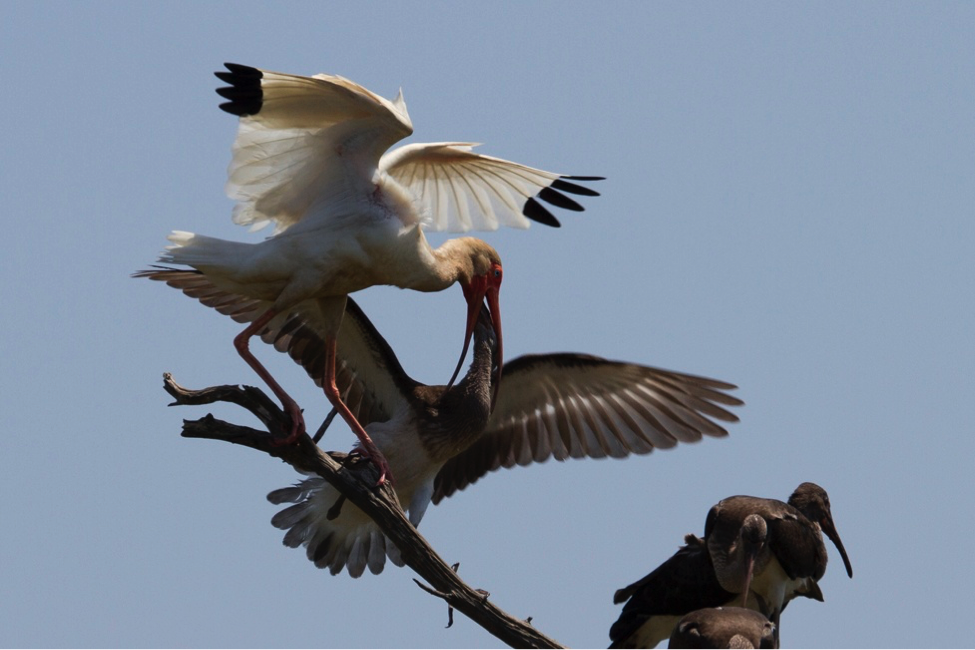For more than 25 years, Audubon North Carolina has managed a network of coastal sites along our state’s coast offering a haven for beach-nesting birds. By protecting the specialized habitats that birds need, shorebirds have a chance to thrive. Read on to learn more about nesting updates from islands along the Cape Fear River and the coastal team who protects them.
Please welcome Lindsay Addison.
Even though summer is still in full swing for crowds of beachgoers, the nesting season is winding down on the Cape Fear River, as new fledglings took to the air.
The Coastal chicks spread their wings:
White Ibis and Great Egrets were the first to test their wings. Following behind were other wading birds like the Tricolored Herons—their fledglings sport bold maroon necks—and Snowy Egrets—smaller but just as stately as the Great Egrets. Although we were not doing productivity monitoring of these species on the river this year, it appears that the wading bird colonies on Battery Island and North Pelican Island produced a bumper crop of chicks.
At their peak, White Ibis chicks—which are brown as first-year birds—covered the trees, obscuring their foliage and causing a great ruckus whenever an adult arrived with food. Finally, the chicks began to follow their parents as they departed on foraging trips.
Later in the summer, we started seeing young ibis away from the nesting colony, learning to find their own food in the green summer salt marshes. Now, when you look up at a flock of ibis, you might see some brown immature birds mixed in with the white adults.

A successful summer spent banding:
With the second half of summer also comes banding on the Cape Fear River. This year, as happens most years, we worked with two long-time researchers, John Weske and Micou Browne, to assist their long-term studies of Royal Terns, Sandwich Terns and Brown Pelicans.
Their goal is to band as many chicks of these species as possible each year, and over time gather re-sights of the birds’ uniquely numbered bands in order to learn about their movements and demographics. The oldest known Royal Tern, for example, was 31 years old and part of John Weske’s study.
With a group of volunteers, we banded 1,825 Royal Terns and 408 Sandwich Terns on South Pelican Island. These species are almost totally dependent on dredged-material islands for nesting habitat.
During the summer, we also got an unexpected visit. While we banded a couple hundred more Royal Terns on Ferry Slip Island, the other dredged-material island on the river, a couple of kayakers landed on shore. They had been blown onto the island by strong winds and currents; they had no intention of landing on the islands or disturbing the nesting birds. Instead, they got a brief introduction to bird banding and a ride back to their launch site.
Following tern banding, we tackled Brown Pelicans. In the past few years, the largest colony on the Cape Fear River has been on Ferry Slip Island. This year we banded 955 chicks from an estimated 500 to 600 pairs. We banded nearly 800 more from nearby North Pelican Island. Brown Pelicans normally live 8 to 10 years in the wild, but can top 20.
These chicks, like the Royal Terns and Sandwich Terns before them, are now learning to fly. They are sleek now, covered in glossy light brown feathers. They can be seen around the islands, making first awkward takeoffs.
The adults will continue to feed them for a short while after fledging, to help them get the best possible start in life. With luck, they will complete their first flights south for the winter and return in following springs to nest on the river like their parents before them.
Learn more about Audubon North Carolina’s conservation efforts to protect the seas and shores our birds need to thrive.



